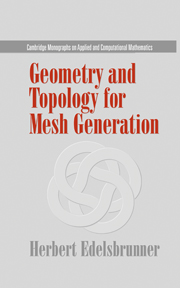3 - Combinatorial topology
Published online by Cambridge University Press: 03 October 2009
Summary
The primary purpose of this chapter is the introduction of standard topological language to streamline our discussions on triangulations and meshes. We will spend most of the effort to develop a better understanding of space, how it is connected, and how we can decompose it. The secondary purpose is the construction of a bridge between continuous and discrete concepts in geometry. The idea of a continuous and possibly even differential world is close to our intuitive understanding of physical phenomena, while the discrete setting is natural for computation. Section 3.1 introduces simplicial complexes as a fundamental discrete representation of continuous space. Section 3.2 talks about refining complexes by decomposing simplices into smaller pieces. Section 3.3 describes the topological notion of space and the important special case of manifolds. Section 3.4 discusses the Euler characteristic of a triangulated space.
Simplicial complexes
We use simplicial complexes as the fundamental tool to model geometric shapes and spaces. They generalize and formalize the somewhat loose geometric notions of a triangulation. Because of their combinatorial nature, simplicial complexes are perfect data structures for geometric modeling algorithms.
Simplices
A finite collection of points is affinely independent if no affine space of dimension i contains more than i + 1 of the points, and this is true for every i. A k-simplex is the convex hull of a collection of k + 1 affinely independent points, σ = conv S.
- Type
- Chapter
- Information
- Geometry and Topology for Mesh Generation , pp. 44 - 67Publisher: Cambridge University PressPrint publication year: 2001



